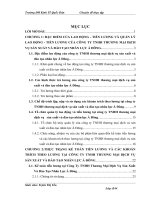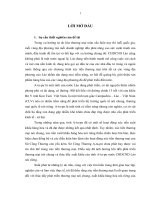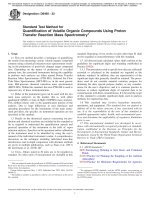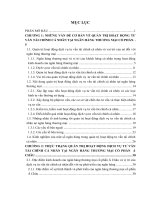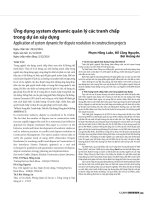Solution manual of environmental chemistry a global perspective 4th s ch07
Bạn đang xem bản rút gọn của tài liệu. Xem và tải ngay bản đầy đủ của tài liệu tại đây (194.84 KB, 10 trang )
Solutions: Environmental Chemistry - a global perspective 4th Edition
Chapter 7
Chemistry of urban and indoor atmospheres
PROBLEMS/SOLUTIONS
1.
Atmospheric pollutants are sometimes classified into two categories:
primary pollutants—those that are emitted directly from the source;
secondary pollutants—those that are produced by reactions in the open atmosphere.
Which category(s) would each of the following fall into: carbon monoxide; carbon dioxide; sulfur
dioxide; nitric oxide; nitrogen dioxide; ozone; PAH compounds; formaldehyde?
Solution
CO – primary pollutant – usually produced during incomplete combustion of carbon-based fuels;
CO2 – primary pollutant – the principal product of combustion of carbon-based fuels. Smaller amounts are
formed in secondary reactions, often involving oxidation via the OH radical;
SO2 – primary pollutant – generated during combustion and smelting processes, and secondary pollutant
formed as an intermediate in the oxidation of reduced sulfur compounds;
NO – primary pollutant – a product of high temperature combustion;
NO2 – secondary pollutant – formed by oxidation of NO;
O3 – secondary pollutant – formed as a side-product during photochemical smog generation;
PAH compounds – primary pollutants – most commonly formed during incomplete combustion of carbonbased fuels, principally coal, diesel and wood;
CH2O – secondary pollutant – formed during photochemical smog events, product resulting from the
oxidation of organic compounds.
2.
The average concentrations (µg m-3) of gaseous pollutants in Krakow Poland have been measured to
be: ozone 43, PM10 39, sulfur dioxide 23 and nitrogen dioxide 44. The maximum one hour level of
ozone was 201 µg m-3. What are the likely sources of these pollutants and which ones appear to be
problems or potential problems in terms of air quality?
Solution
The likely sources of these pollutants are from both industrial (burning S-containing coal for fuel) and
automobile (internal combustion) emissions in this highly populated urban centre. A by-product of smog
formation is the production of ozone. The 43 µg m-3 O3 is not of particular concern, but the 201 µg m-3 O3
for 1h exceeds the recommended EU and WHO guidelines. PM10 comes very close to the EU guideline of
50 µg m-3 for a 24h period. Particulate matter is often released from large coal burning furnaces without
proper particulate emission control (as discussed in Chapter 6). The sulfur dioxide exceeds the EU 1 y
level, and the nitrogen dioxide exceeds both the EU and WHO l y levels. These last two values would only
be of concern, if the reported values above were 1 y averages. Otherwise they fall well below short term
limit exposures.
49
Solutions: Environmental Chemistry - a global perspective 4th Edition
Chapter 7
3.
Chemistry of urban and indoor atmospheres
A measurement of AQI given in terms of sulfur dioxide (1 h) is 109. What is the actual mixing
ratio of sulfur dioxide? Note that unless the actual chemical is specified, the AQI is unable to provide
specific information about the cause of any potential air quality problem.
Solution
Use Equation 7.1, Table 7.3, and Example 7.1 as a guide.
The value of 109 for SO2 falls in the range of ‘unhealthy for sensitive group’ 101-150 (orange). We can
then expect that the mixing ratio will lie in the range of: 0.076-0.185 ppmv.
I
I high I low
Chigh Clow
(C Clow ) I low
7.1
From Table 7.3 in the ‘unhealthy for sensitive group’ 101-150 (orange) row, data for SO2 is:
Ihigh
Ilow
Chigh
Clow
= 150
= 101
= 0.185
= 0.076
C
= ? (what we are solving for)
Given I (AQI) = 109.
Solve:
109 = (49/0.109) x (C – 0.076) + 101
8 = (449.541) x (C – 0.076)
8 = 449.541C – 34.165
449.541C = 42.165
C = 0.0938 ppmv
The AQI value of I = 109 for sulfur dioxide (1 h) has the actual mixing ratio of 0.094 ppmv SO2.
4.
Not every country uses the EPA air quality index that we have described in this chapter. Search to
find out about the index employed by your country or one nearby. Compare it with the EPA index
Solution
For classroom discussion, no solution provided. How many different example were identified?
How many countries use the same index? How many countries have no index?
5.
Access the Air Now website (Additional Resources 4) and go to the international listings (under the
quick links near the bottom of the page). Choose the United Kingdom, London Air Quality Network
link and then on the next page from the main menu bar select Download Data. From the sites
menu, fetch Windsor Roadside and on the next screen choose oxides of nitrogen. Follow the trend in
50
Solutions: Environmental Chemistry - a global perspective 4th Edition
Chapter 7
Chemistry of urban and indoor atmospheres
oxides of nitrogen using both 15 min and 1 h data for the one-day period July 1 to July 2, 2008.
Explain the observed trend and compare the peak values with the WHO guideline for this pollutant.
Solution
For: Windsor and Maidenhead – Clarence Road (Windsor Roadside was not a choice)
For the 15 min and 1 h data for NO2 (Oxides of Nitrogen) July 1 - July 2: The returned graphs shows a
significant rise in NO2 from early morning (5 am) until noon, peaking at near 350 µg m-3 at approximately
7 am. NO2 levels fall to near 60 µg m-3 around noon, and then rises slightly (120 µg m-3) through the late
afternoon and early evening, before falling to the lowest level (30-40 µg m-3) achieved in the overnight
period. This trend is depicted in both the 15 min and 1 h graphs shown below. The observed trend is the
typical trend for nitrogen oxide emissions emanating from automobile exhaust in morning and late day
traffic. The peak value of near 280 µg m-3 exceeds both the EU and WHO 1 h limits. The approximate
overnight values of 30-40 µg m-3 are very close and may exceed the EU 30 and WHO 40 µg m-3 1 y limits.
The y-axis label in both graphs is NO2 (µg m-3).
51
Solutions: Environmental Chemistry - a global perspective 4th Edition
Chapter 7
6.
Chemistry of urban and indoor atmospheres
Access the Air Now website as above and choose the Federal Environmental Agency Germany – Air
Quality Division. The information can be accessed in either German or English. For the current day,
examine the maps of Germany that depict ozone, carbon monoxide, nitrogen dioxide and sulfur
dioxide, following the time period from 6 am to 12 noon. Comment on the changing pattern over the 6
hour period, taking into account the locations of different values and the time of the year during which
the information is provided. Also comment on the daily mean PM 10 value provided. How do the
German data compare with WHO guidelines?
For classroom discussion, no solution provided. Provide a demonstration in class using this problem as
an example. What other regions can be investigated? How could ‘apps’ be used for information such as
this?
7.
The indoor / outdoor concentration ratios for carbon monoxide are usually near 1, for carbon dioxide
they are usually greater than 1, and for sulfur dioxide they are usually less than 1. Give reasons for
these normal situations and cite instances that might be exceptions to the values.
Solution
CCO in
---------- ≈ 1
CCO out
CCO2 in
---------CCO2 out
>1
CSO2 in
----------- < 1
CSO2 out
CO is primarily produced in combustion processes where incomplete oxidation of carbon occurs, such as in
automobile engines (although catalytic converters have reduced much of the earlier CO emissions in North
America and Europe). The concentration of CO is controlled mainly by the hydroxyl radical where CO is
oxidized to CO2 (see Chapter 2, Reaction 2.25). Since there is no other specific removal or generation
52
Solutions: Environmental Chemistry - a global perspective 4th Edition
Chapter 7
Chemistry of urban and indoor atmospheres
process of CO inside over that of outside, the ambient outside CO concentration will be the approximately
the same as the inside air, even with only limited mixing between the two.
The presence of a wood-stove (for cooking or heating) in the dwelling or an attached parking garage, or
heavy smokers, could lead to situations where the CO concentrations indoors may be higher than those
outside. (i.e., having a source for CO emissions inside).
CO2 concentrations indoors may be higher than outdoor concentrations due to the fact that humans produce
carbon dioxide in our respiratory process, which adds to the ambient indoor concentration. This would
likely occur more often during times of cooler weather in a well sealed home or office where little mixing
would occur between the outside and indoor air and with gathering of many people in a relatively small
enclosed location.
Situations which may lead to lower indoor CO2 concentration, would be homes or offices that have a very
efficient air re-circulating system with outdoor air or ones that have many plants which could act as a ‘sink’
for the CO2 produced, and help remove it from the air.
Sulphur dioxide concentrations are lower indoors than outdoors due to its short atmospheric lifetime. The
short time intervals (measured in days – weeks) does not permit sufficient time for complete mixing and
equilibration of concentrations of the indoor air and outdoor air. The point source emissions of SO2 are
almost exclusively outdoors, including factories burning high sulphur fuels and plants involved in smelting
of metal sulphides.
Possible variations from the ratio shown above could include, indoor/outdoor locations in remote areas (not
influenced by SO2 emissions) may have similar concentrations to each other and a ratio closer to 1. A
second, unlikely scenario, is for a source of SO 2 to be located inside, this would create a situation where the
indoor air is greater in SO2 than outdoor air.
8.
In the uranium-238 decay series, radium-226 is an immediate radioactive parent of radon-222.
Consider its position in the periodic table and indicate its usual oxidation state, its probable mobility
in water, and factors affecting its solubility in soil / water systems.
Solution
Uranium-238 (U - atomic number 92)
Radium-226 (Ra - atomic number 88)
Radon-222
(Rn - atomic number 86)
Radium-226 has a half-life of about 1660 years, and is an alkaline earth metal with a usual oxidation state
of +2. It is likely that Ra2+ is a reasonably soluble metal cation. For example, if it were paired with chloride
or nitrate in an aqueous environment it would be dissociated, while it would be expected to precipitate out
of water in the presence of other common environmental anions such as sulfate and carbonate. As it decays,
it will release the gaseous Rn, whether in an aqueous or solid system.
Radon 'gas' is one of the ‘Nobel’ gases (Group 8A or more commonly now called Group 18) and its usual
oxidation state is zero. Rn has a completely filled valence shell and it is unfavourable for it to either gain or
lose an electron. Radon is a gas at standard temperature and pressure and would likely be quite mobile
(subject to wind and diffusion). Radon is also a very heavy gas, so if released to the atmosphere, it would
stay very low to the ground or be most concentrated in the air immediately above surfaces, including soil
and water. These increased concentrations or partial pressures of radon-222 would tend to cause increased
concentrations within the water/soil systems that it is in contact with.
53
Solutions: Environmental Chemistry - a global perspective 4th Edition
Chapter 7
9.
Chemistry of urban and indoor atmospheres
As an experiment, gas cooking units were activated until high levels of carbon monoxide and NO x
compounds were measured in a house and then the gas burners were turned off. The carbon dioxide
levels returned to background values in 1.6 h, but the NO x levels only required 0.7 h before they had
reached the ‘normal’ concentration. Suggest an explanation.
Solution
NOx species are more reactive than CO species. Even within the indoor air there are many oxidizing agents
(e.g. small amounts of O3 produced by various electrical devices) that will convert NO to NO 2, similar to
night-time chemistry (see Night-time chemistry in Section 5.2). Further oxidation to HNO3 for removal of
NOx is also possible. The OH radical will also oxidize NO and react with NO 2 on its way to forming
HNO3. CO has only one major route for oxidation, and that is with the hydroxyl radical (Chapter 2,
Reaction 2.25). CO would be in competition with the more reactive NOx for the hydroxyl radical.
Therefore, it would not be until most of the NOx is removed that any noticeable decrease in CO would be
noticed.
10.
In Chinese village homes, heating is often done by an open wood or coal fire. Where outdoor PAH
concentration is 0.60 ng m–3, the rate of emission of PAH from indoor combustion is 3.5 ng m –3 h–1,
and the air exchange rate is 2 h–1, estimate the indoor air concentration of PAH compounds. Assume
that the only loss mechanism is by air exchange.
Solution
Data: PAH (outdoors) 0.6 ng m-3, rate of emission (indoors) = 3.5 ng m-3 h-1 , exchange rate is 2 h-1
What is the indoor air concentration of PAHs?
Equation 7.4 can be readily applied to this situation
Ci = Co + Ri/ke
where Ci and Co refer to the indoor and outdoor concentrations of PAHs, R i is the rate of production of
PAHs and ke is the exchange rate.
Ci = 0.6 ng m-3 + 3.5 ng m-3 h-1 ÷ 2 h-1 = 2.35 ng m-3
The indoor air concentration of PAH compounds is about four time larger than the outdoor concentration
under these conditions suggesting that the open wood or coal fire would be contributing to poor indoor air
quality.
11.
At a gathering of 30 people in a room 6 m × 9 m × 3 m, half are smoking, on average, 3 cigarettes per
hour. Each cigarette when smoked releases 2.4 mg of formaldehyde. The air exchanges five times
every hour. Assuming that the outdoor formaldehyde concentration is negligible, calculate the steadystate concentration in the air inside the room. Does this concentration exceed the concentration (100
ppbv) considered to be the level of concern?
54
Solutions: Environmental Chemistry - a global perspective 4th Edition
Chapter 7
Chemistry of urban and indoor atmospheres
Solution
Assume that P = 101 325 Pa and that T = 298 K. (use R = 8.314 J mol-1 K-1)
The volume of the room is determined from its dimensions:
6 m x 9 m x 3 m = 162 m3
(We will ignore the loss of volume due to occupants and material items.)
The total number of moles of gas in the room can be determined from PV = nRT.
n = PV/RT
n = 6625 moles (total gas in room)
Rate of formaldehyde (CH2O) produced from cigarettes (cig.) is
30 persons ÷ 2 x 3 cig. hr-1 persons-1 x 2.4 mg (CH2O) cig.-1 = 108 mg (CH2O) hr-1
Use equation 7.4 (with units of absolute amounts in place of concentration) Ci = Co + Ri / ke where Ci
and Co refer to the indoor and outdoor amounts of formaldehyde, Ri is the rate of production and ke is the
air exchange rate, and assume no contribution from outside.
Ci = 0 mg + 108 mg h-1 ÷ 5 h-1 = 21.6 mg
The steady-state amount of formaldehyde in the room is 21.6 mg. The state-state concentration of
formaldehyde in ppbv can now be calculated.
Moles of formaldehyde in the room is:
2.16 x 10-2 g ÷ 30.032 g mol-1 = 7.19 x 10-4 mol (CH2O)
mixing ratio (ppbv) of formaldehyde is:
7.19 x 10-4 mol ÷ 6625 total moles x 109 ppbv = 109 ppbv (CH2O)
Even with the very high exchange rate of air in the room, the 100 ppbv level of concern is exceeded.
12. A beaker of benzene is left open in a closed lab of dimensions 4.2 m x 5.0 m x 2.6 m. It evaporates at a
rate of 7 mL per hour. The air exchange rate in this unventilated room is 0.3 h -1. Room temperature is
20oC and pressure is Po. What is the steady state mixing ratio of benzene in the air of this room.
Suppose the room is now a properly ventilated lab with air exchange rate of 2.5 h-1. Recalculate the
steady state mixing ratio of benzene.
Solution
Volume of room = 54.6 m3 (P = 101325 Pa, T = 293 K, R = 8.314)
Total moles of gas in room = 2271 moles
The density of benzene at 20oC is 0.8865 g mL-1
Mass of benzene released = 7 mL h-1 x 0.8865 g mL-1 = 6.2 g h-1
55
Solutions: Environmental Chemistry - a global perspective 4th Edition
Chapter 7
Chemistry of urban and indoor atmospheres
Use Equation 7.4 (with units of absolute amounts in place of concentration) Ci = Co + Ri / ke where Ci
and Co refer to the indoor and outdoor amounts of benzene, Ri is the rate of production and ke is the air
exchange rate, and assume no contribution from outside.
Ci = 0 g + 6.2 g h-1 ÷ 0.3 h-1 = 20.7 g
The steady-state amount of benzene in the room is 20.7 g. The state-state concentration of benzene in ppbv
can now be calculated. Moles of benzene in the room is:
20.7 g ÷ 78.1121 g mol-1 = 0.265 mol (benzene)
mixing ratio (ppmv) of benzene is:
0.265 mol ÷ 2271 total moles x 106 ppmv = 117 ppmv (benzene)
For 2.5 h-1
Ci = 0 g + 6.2 g h-1 ÷ 2.5 h-1 = 2.48 g
2.48 g ÷ 78.1121 g mol-1 = 0.03175 mol (benzene)
0.03175 mol ÷ 2271 total moles x 106 ppmv = 14 ppmv (benzene)
13. A basement apartment is situated in an area where the outdoor radioactivity is 3 Bq m -3. The
construction materials and surrounding soil release radon into the basement atmosphere at a rate of 72
Bq m-3 h-1. With open windows etc., the summer exchange rate is 8 h-1 while in the winter it is 0.4 h-1.
Calculate the steady state radon activity in both seasons and compare to the WHO reference levels.
Solution
Use Equation 7.8,
Ai = (Ri + keAo) / (kd + ke)
where,
Ai = ?
Ao = 3 Bq m-3
Ri = 72 Bq m-3 h-1
ke = 8 h-1 (summer), 0.4 h-1 (winter)
kd = 0.0076 h-1 (note Rn half life = 3.8 days = 91.2 h, kd = ln 2 / 91.2 h = 0.0076 h-1)
Solving for:
Summer
Ai = (72 Bq m-3 h-1 + 8 h-1 x 3 Bq m-3) / (0.0076 h-1 + 8 h-1)
= 96 Bq m-3 h-1 / 8.0076 h-1
= 12 Bq m-3
Winter
Ai = (72 Bq m-3 h-1 + 0.4 h-1 x 3 Bq m-3) / (0.0076 h-1 + 0.4 h-1)
= 73.2 Bq m-3 h-1 / 0.4076 h-1
= 180 Bq m-3
56
Solutions: Environmental Chemistry - a global perspective 4th Edition
Chapter 7
Chemistry of urban and indoor atmospheres
The summer condition is near what is considered to be in the low category while the winter condition
exceeds the 100 Bq m-3 that WHO recommends not be exceeded to minimize health hazards associated
with exposure.
14. A common occupational exposure standard is that workplace oxygen concentrations should not be
lower than 19.5%. Assuming that combustion to produce carbon dioxide was the cause of a decrease,
what would be the carbon dioxide level, if all this occurred in a closed system?
Solution
Start by assuming the concentration of oxygen was 20.95% to begin with. Back in Chapter 2, Problem 1, we
calculated that this was equal to 8.56x10-3 mol L-1 O2. We can repeat the same calculation for 19.5%
oxygen and obtain the value of 7.97x10-3 mol L-1 O2.
Assuming Pa =101 325, 25°C and using PV=nRT (where R = 8.315 J K-1 mol-1, V = 1.00x10-3 m3)
n = 0.04089 mol
oxygen mixing ratio = 7.97x10-3 mol / 0.04089 mol x 100% = 19.5%
Using a 1.00 L volume,
8.56x10-3 mol - 7.97x10-3 mol = 5.86x10-4 mol O2
(consumed in the combustion)
The general combustion equation (using only carbon) shows that there is a 1:1 molar relationship
between O2 consumed and CO2 produced. (Note: different types of fuels will have different
stoichiometric relationships of O2 consumed to CO2 produced, e.g., Ethanol is 1.75:1, while butane is
1.6:1)
C + O2 CO2
Using only
Moles of CO2 produced = 5.86x10-4 mol ( = mol of oxygen consumed, assuming 1:1)
The new mixing ratio for CO2 = 5.86x10-4 mol / 0.04089 mol x 100% = 1.434%
The mixing ratio for CO2 is 1.4%.
The mixing ratio of 1.4% for CO2 is well above the usual amount of about 0.04% (which was deemed
negligible and not needed in this calculation)
15. In California, ambient outdoor formaldehyde concentration is typically 4.0 μg m-3. If formaldehyde in
an office is found to be present at 39 μg m-3 and the air exchange rate for the office is 3 h-1, at what rate
is formaldehyde being degassed from the walls, furnishings etc.?
Solution
Use Equation 7.4
Ci = Co + Ri/ke
where Ci (39 μg m-3) and Co (4.0 μg m-3) refer to the indoor and ambient outdoor concentrations
repectively, Ri is the rate of formaldehyde being degassed from the walls, furnishings etc., and ke (3 h-1) is
the exchange rate. (See Example 7.3)
39 μg m-3 = 4.0 μg m-3 + Ri / 3 h-1
57
Solutions: Environmental Chemistry - a global perspective 4th Edition
Chapter 7
Chemistry of urban and indoor atmospheres
35 μg m-3 =
Ri / 3 h-1
Ri = 105 μg m-3 h-1
The rate the formaldehyde is being degassed from the walls, furnishings etc. is 105 μg m-3 h-1.
16. The website o/, accessed November, 2016, gives real time data on important air quality
parameters for many cities on all continents around the world. Access this website and do the
following:
a. Find your city and examine its present air quality. Over the past 24 hours, does it show the expected
trends related to changing human activity? How do the data compare with the WHO guidelines
regarding air quality?
b. If the season is appropriate, compare your data with those for a similar sized city in the other
hemisphere.
c. Examine the data for a remote site such as an island in the middle of one of the major oceans, or a site
relatively high in a remote area in the Himalayas. What do these data say about global air quality?
For classroom discussion, no solution provided.
58
